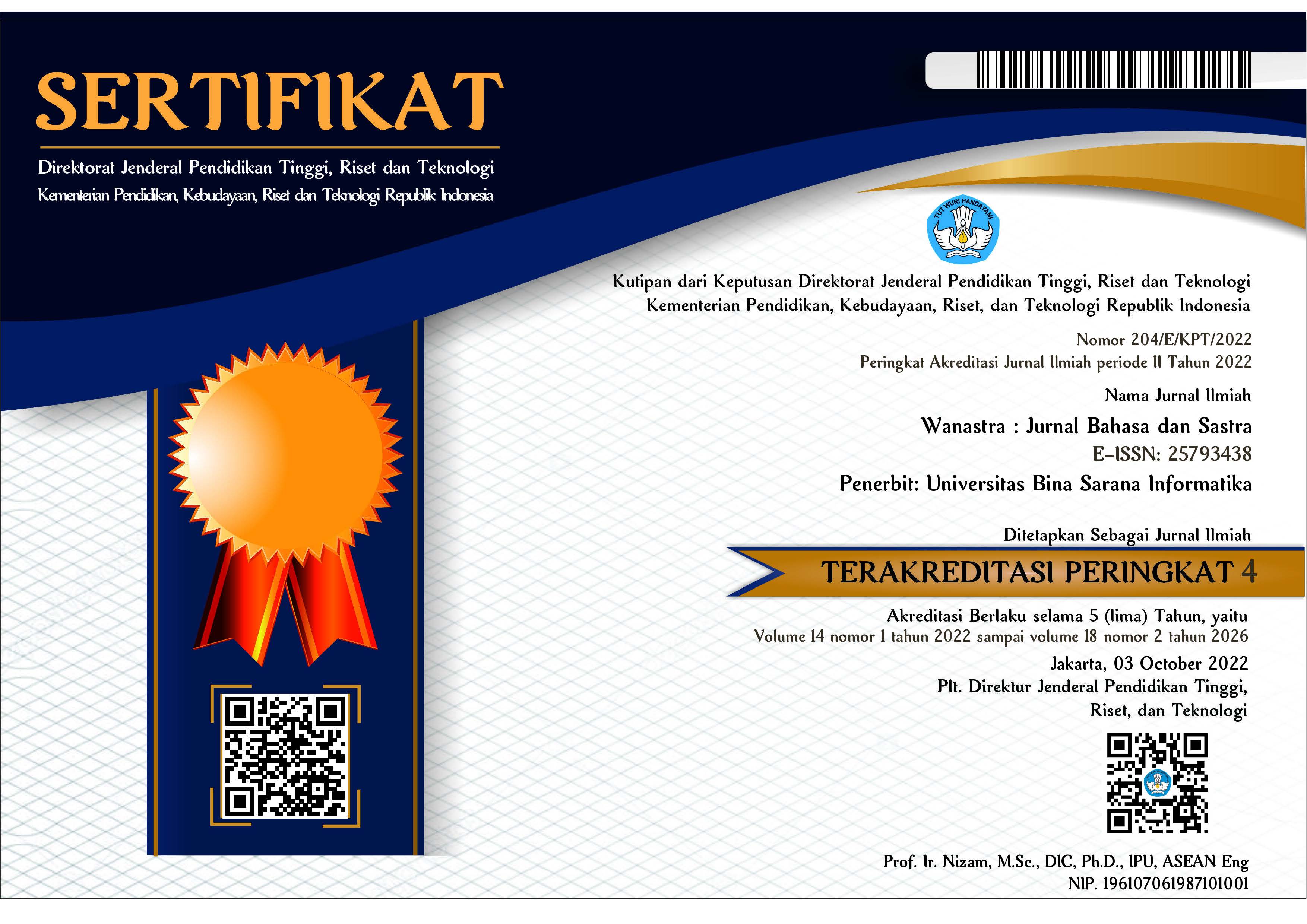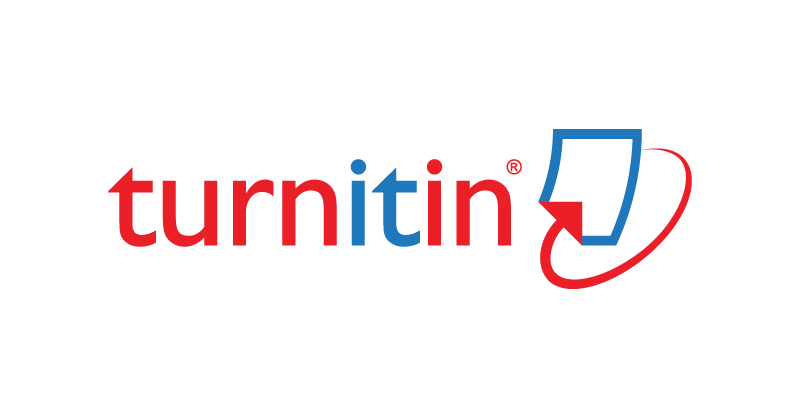Online Submissions
Already have a Username/Password for Wanastra : Jurnal Bahasa dan Sastra?
Go to Login
Need a Username/Password?
Go to Registration
Registration and login are required to submit items online and to check the status of current submissions.
Author Guidelines
The article has never been published in other media and no plagiarism. A plagiarism-free statement can be included in a document signed by the author and uploaded to the supplementary file (step 4), or it can also be attached to the results of a plagiarism check. The manuscript should be in English.
The writing format is one column using A4 paper size (21x29.7cm). Text margins from left and top are 3 cm, right and bottom are 2 cm. Manuscripts are written in Microsoft Word, single spaced, Times New Roman 10pt and a maximum of 12 pages. Paragraph settings with a distance of 10pt on the after spacing and do not use the First Line Indent.
The title of manuscript should describe the content and use the fewest possible words. Avoid using words that make too long such as "A Study of...", "Investigation of...........", "Implementation............", "Observation on......", "Effect......", "Analysis....", "Design...", etc. Article search depends on the accuracy of the title, the keywords also help in searching references.
The maximum number of words in the title is 14 words (English) which refers to the Higher Education Accreditation rules.
Introduction: If the research has high originality and proposes a new method or algorithm, additional chapters after the "Introduction" and the "Research Method" can be added to briefly explain the proposed method or algorithm. The Introductory Chapter may also contain supporting theories of proposed methods for solving a problem and the development of such methods based on clear references (books, journals, proceedings and other scientific articles).
Research Methodology: describing the chronological research, including research design, research procedures (in the form of algorithms, Pseudocode or others), and how to test and acquire data. References should support the research program description; thus, the explanation can be accepted scientifically.
Results and Discussion: the results are explained and simultaneously comprehensively discussed. Results can be presented in numbers, graphs, tables, or else, making the reader understand easily. This section emphasized the novelty of research that contains innovation and its implications. Discussions can be made in several sub-chapters.
Conclusion: Provide a statement that is expected and stated in the "Introduction" may eventually result in "Results and Discussions"; the end is compatibility. In addition, the prospect of developing research results and implementing advanced studies can also be added. Avoid Statistical Data and submit recommendations for future research based on sources.
Reference: The main references are international journals and national journals or ISBN-based books. All references should be the most relevant and the latest sources. References are written in APA style. Each quote must be written in ascending order (A-Z). There is no need to be grouped by book or journal. References from the website/internet URL can be obtained from reliable sources. References should be written using the help of reference managers software such as Mendeley or others with a minimum number of 15 references (ten international reputation articles, five national reputation articles).
Additional information:
1. Document Display Format
The abstract writing format is written in one paragraph and italicized. The manuscript from Introduction to Reference is made in a two-column model. Headings in Tables and Figures use table numbers 1, Table 2, etc. Or Figure 1, Figure 2, etc. Table shapes use only horizontal line designs for each data fill (Marcoulides, 2005). An example can be seen in Table 1.The letters in the table use Times New Roman size 9, and each foreign word is italic.
2. Equations and symbols
The equation is written in italic and numbered in parentheses. The citation of the equation must be in the form of "equation (2)". All symbols must be defined in the body of the manuscript.
Submission Preparation Checklist
As part of the submission process, authors are required to check off their submission's compliance with all of the following items, and submissions may be returned to authors that do not adhere to these guidelines.
- The submission has not been previously published, nor is it before another journal for consideration (or an explanation has been provided in Comments to the Editor).
- The submission file is in Microsoft Word document file format.
- Where available, URLs for the references have been provided.
- The text is single-spaced; uses a 12-point font; employs italics, rather than underlining (except with URL addresses); and all illustrations, figures, and tables are placed within the text at the appropriate points, rather than at the end.
- The text adheres to the stylistic and bibliographic requirements outlined in the Author Guidelines, which is found in About the Journal.
- If submitting to a peer-reviewed section of the journal, the instructions in Ensuring a Blind Review have been followed.
Copyright Notice
Copyright Policy Statement
Authors who publish their manuscripts through Wanastra : Jurnal Bahasa dan Sastra agree on the following:
1. The copyright holder of the article is the author(s).
2. The author gives the right to publish the scientific articles to Wanastra : Jurnal Bahasa dan Sastra as the first publisher. The author gives permission/license regarding the Creative Commons Attribution License to other parties to distribute the articles.
3. Non-exclusivity stuff in Journal distribution publishes the author's scientific articles can be agreed upon separately (e.g., a request to insert in institution library or publish as a book) then adjust the author as one of the parties and Wanastra : Jurnal Bahasa dan Sastra as the first publisher.
4. Authors can publish the article online before and during the manuscript submission process (e.g., in the Repository or on the organization's/institution's website), as this can promote the earlier and exchange of citations.
5. Manuscripts and related materials published through this Journal are distributed under a Creative Commons Attribution-ShareAlike 4.0 International License (CC BY-SA)
Privacy Statement
The names and email addresses entered in this journal site will be used exclusively for the stated purposes of this journal and will not be made available for any other purpose or to any other party.
Author Fees
This journal charges the following author fees.
Article Publication: 300000.00 (IDR)
If this paper is accepted for publication, you will be asked to pay an Article Publication Fee to cover publications costs.
If you do not have funds to pay such fees, you will have an opportunity to waive each fee. We do not want fees to prevent the publication of worthy work.







